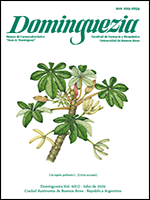Valuation of antidiarrheal capacity of aerial parts lyophilized aqueous extract from Conyza bonariensis (L.) Cronquist (Asteraceae) in animal models
Keywords:
Conyza bonariensis, antidiarrheal activity, animal modelsAbstract
Conyza bonariensis (L.) Cronquist (Asteraceae), commonly known as “rama negra” or “yerba carnicera”, is a native annual herb referenced as antidiarrheal in popular medicine. Our objective was to evaluate the potential usefulness of the aerial parts lyophilized aqueous extract from C. bonariensis (EALCB) as an antidiarrheal by the techniques of intestinal transit, intestinal fluid accumulation (enteropooling) and castor oil-induced diarrhea. Plant material was collected in the San Luis province. An infusion was prepared in a 1:10 ratio and the aqueous extract obtained was concentrated and lyophilized. The animals (Balb/c mice and Wistar rats) in each experiment were divided into 6 batches: negative control (vehicle; saline solution), positive control [Reference drugs: Morphine sulfate (10 mg/kg, p.o.), Loperamide (10 mg/kg, p.o.) and Chlorpromazine (10 mg/kg, i.p.), respectively for intestinal transit, intestinal fluid accumulation and castor oil-induced diarrhea] and one batch for each dose of EALCB (125, 250, 500 and 1000 mg/kg, p.o.). Records from each batch were compared vs. negative control by 1-way ANOVA and subsequent analysis by Dunnett's multiple comparison test. Data were expressed as the Mean ± S.E.M. A probability of p<0.05 was considered significant. EALCB produced a significant statistically decrease [F(4,35)=6; p<0.01] of the normal peristalsis, however, it did not produce a significant statistically variation [F(4,35)=1; p=ns] in the enteropooling, weight and volume of the intestinal content. In castor oil-induced diarrhea, only the two highest doses caused a significant statistically decrease in the severity of experimentally induced diarrhea (p<0.05 and p<0.001, respectively). EALCB demonstrated a protective effect against hypermotilitic diarrhea but not against hypersecretory diarrhea. Several secondary metabolites could be responsible for the observed effect, although more research is necessary to determine the specific action mechanism and relate the antidiarrheal effect to an active ingredient(s).



